Abstract
Natural and anthropic disasters produce relevant economic and environmental losses at a global level. Many countries have adopted a risk management cycle to limit these losses. Agenda 2030 defined specific Sustainable Development Goals (SDGs) and relative targets dedicated to disaster risk reduction. Planned actions can pertain to the context “before” or “after” a disastrous event. The United Nations recommend a risk-informed approach for achieving the SDGs by working on anticipation and prevention. Planning with training and exercises, referring to transport systems in emergency conditions, can limit disaster impacts and strongly support the pursuit of sustainability. This research focuses on actions and methodologies for increasing preparedness levels “before” a disastrous event, to improve the capabilities of managers and people by increasing awareness of the effects of planned actions. Transport system models (TSMs) play an important role in simulating the evacuation of people to reduce theoretical risk, thereby reducing theoretical exposure. In this work, a method is presented that allows us to investigate how this theoretical reduction can become effective, through training and exercises. The paper proposes a general framework of training and exercises for risk reduction based on a given transportation planning model. The framework supports ex ante evaluations of exposure reduction produced by an evacuation plan. The obtained results show that the effectiveness of the planned actions increases with different levels of exercise implementation. The progressive implementation of exercises contributes to achieving the risk reductions estimated at the evacuation planning stage. The TSM in the mitigation phase is the basis for the development of specific quantitative evacuation plans, that must be implemented in the preparedness phase by means of training and exercises to test the planned actions in terms of reducing the exposure risk component. Some exercises implemented worldwide verify the proposed framework by means of some empirical evidence. The results and discussions reported in this paper can be useful for researchers, decisionmakers, and society by offering a contribution to the growing knowledge about risk and the potential actions and their relative effects on reducing it.
1. Introduction
In recent years, at the global level, the number of natural and anthropic disasters is increasing. According to the international disaster database produced by the Centre for Research on the Epidemiology of Disasters (CRED) [1], in 2020, at the global level, disasters produced by natural events affected about 100 million people, produced an economic loss of about 190 billion USD, and resulted in 15,082 deaths [2].
After some of these disasters, on all continents, the level of awareness about the implementation of evacuation exercises of different types increased. On 5 November 2016, on the occasion of the “World Tsunami Awareness Day”, about 30,000 people were evacuated as part of the “IOWave16” test, implemented to verify the effectiveness of the Indian Ocean Tsunami Early Warning System [3]. The necessity of increasing knowledge about disaster risks and relative preparedness started at the beginning of the century. Hurricane Katrina, in 2005, produced catastrophic consequences in New Orleans and all of Louisiana, accounting for about 1570 deaths and $40–50 billion in monetary losses. The greater part of the consequences affected more vulnerable populations who did not have autonomy in mobility for different reasons (poverty, health, age, etc.) [4]. Hurricane Katrina demonstrated the necessity of organizing collective transport services to evacuate vulnerable or special-needs users.
The main example, in the case of anthropic disasters, is the terrorist attack on the World Trade Center in New York on 11 September 2001 (9/11). It resulted in about 3000 deaths and thousands more people injured. The 9/11 Commission Report underlined that “neither full nor partial evacuation drills were held” [5].
In the USA, the necessity of increasing the preparedness level for evacuation procedures came into being in the new millennium, as a fundamental element of efforts to reduce human losses.
Not all countries invest the same efforts as the USA to reduce risk. In 1992, the European Union created the Directorate for European Civil Protection and Humanitarian Aid Operations (DG ECHO). In 2010, DG ECHO introduced the “EU Civil Protection Mechanism” and the “EU’s Emergency Response Coordination Centre” [6]. Despite these institutional frameworks, in Europe there is no standard emergency management procedure that obliges member states to test emergency plans with a systematic cycle of exercises. The European Commission (EC) is highly focused on actions to be implemented “after” a disaster. However, the two events that occurred in the USA focused the country heavily on the “before”. Then, the approach can schematically be defined as: USA, before; other countries, after.
The subscriber countries share the Sustainable Development Goals defined by Agenda 2030. Those strictly connected to disaster risk reduction are: SDG 1—“End poverty in all its forms everywhere”; SDG 11—“Make cities and human settlements inclusive, safe, resilient and sustainable”; SDG 13—“Take urgent action to combat climate change and its impacts” [7]. The United Nations (UN) recommend a risk-informed approach to achieving the SDGs, “bridging the gap at the science–policy interface” and working on “anticipation, prevention and risk reduction” [8]. In particular, it is necessary to recall target 11.5 and its related indicators: indicator 11.5.1—number of deaths, missing persons and directly affected persons attributed to disasters per 100,000 population and indicator 11.5.2—direct economic loss in relation to global GDP, damage to critical infrastructure and number of disruptions to basic services, attributed to disasters. Note that indicator 11.5.1 is the same as indicator 13.1.1.
In a synthetic way, from the scientific literature, risk can be factorialized into three components: occurrence, which is related to the probability of a disastrous event occurring; vulnerability, which is related to the system’s resistance to disaster’s effects; and exposure, which is related to the quantity of people and goods present in the area affected by disaster. To reduce risk, it is possible to plan and implement actions related to one or more of these components.
The set of possible actions for risk reduction constitutes the core of the risk management cycle encompassing the phases of: mitigation or prevention of the emergency events (e.g., planning); preparedness, aimed at improving the capability of managers and people by increasing awareness of the effects of planned actions (e.g., training or exercising); response in terms of controlling, limiting, and reducing the event’s consequences (e.g., aid during an emergency); recovery, which is for restoring normal conditions after the effects of the event have ended. Figure 1 represents the different phases in a bow-tie diagram ([9,10]). Disaster management, with specific reference to transport systems in emergency conditions, can be supported by consolidated methodologies generally adopted for sustainable mobility planning, policies, and governance.
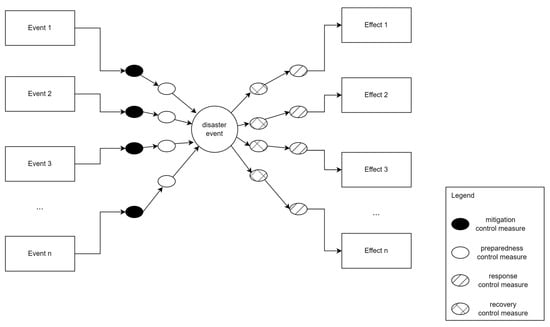
Figure 1.
Bow-tie diagram with phases for risk reduction.
The United Nations Office for Disaster Risk Reduction (UNDRR) emphasizes the necessity of enhancing disaster preparedness in order to increase the response capabilities of the involved actors. With this aim in mind, UNDRR proposes a “people-centered approach” according to the Sendai Framework for Disaster Risk Reduction 2015–2030. The approach is aimed at understanding risk by means of risk assessment and investment in preparedness actions [3]. The enhancements contribute to increasing the capabilities of people and managers; at the same time, the efforts of planning and exercises contribute to risk reduction.
The literature indicates that the repetition of the evacuation exercise activity in the same area produces a reduction in different indicators of exposure such as evacuation times. A full-scale exercise performed two times in the same town in the south of Italy produced a reduction in evacuation time of 20%, measured as the difference between the two exercises [11]. At the same time, the literature underlines shortcomings regarding the estimation of outcomes and goals produced by exercises at different levels [12,13]. In this context, it is useful to recall the role of Transport System Models (TSMs) for simulating systems under evacuation conditions. The travel users’ choices (e.g., departure time, transportation mode, route, etc.) produce relevant impacts on transportation system performance, influencing evacuation outcomes. The application of a TSM provides more insights into the effects produced by an evacuation with the aim of supporting planning and communication strategies [14,15]. The combination of simulation modeling and exercises empowers decisionmakers in terms of testing the effects of planned actions “before” a disastrous event. In this sense, training and exercises have a twofold relevance:
- On the one hand, exercises aid emergency planners and managers in verifying some problems relating to emergency action implementation, putting into practice the emergency planning context, and increasing the awareness of affected people regarding the correct travel choices to be adopted during an evacuation;
- On the other hand, exercises are useful for collecting data and information on increasing the TSM’s capacity to represent reality by means of new calibration of demand models and supply functions.
In this context, this research focuses on preparedness activities implemented before the event to increase the capabilities of people, risk managers, and decisionmakers to improve planned actions during an event. In particular, actions for reducing exposure are focused on. These activities regard evacuation planning for a portion of an urban area or a single building. Transportation systems play a relevant role in evacuating people. An efficient transport system contributes to reducing the risk exposure component of moving people from an area where a dangerous event is taking place to safe places where the effects of the dangerous event are undetectable. Public decisionmakers and the agencies involved in emergency management processes seek to improve evacuation planning and implementation with a specific focus on mobility management before and during an evacuation. In the context of this research, this paper formalizes the role of training and exercises in increasing preparedness.
The participants of an exercise can test their role in an “informal stress-free environment” [16]. In fact, with training and exercises, it is possible to test the evacuation plan and the planned actions in order to evaluate potential gaps in terms of real-world implementation.
From the considerations reported above, the following research questions emerge:
- How it is possible to integrate planning, exercises, and a TSM with increasing community preparedness?
- Is it possible to achieve the risk reduction provided by a theoretical planning approach when designing and implementing exercises?
After this introduction, the paper has four sections. Section 2 underlines the necessity of achieving integration between planning, exercises, and evaluation methods in terms of increasing a community’s preparedness. Section 3 describes the main characteristics of exercises and training actions. Section 4 discusses the main obtained results from the implementation of real exercises. Section 5 closes the paper with some final remarks.
The results and discussion reported in this paper can be useful for: researchers who seek insight into scientific methods about emergency planning and implementation; decisionmakers involved in emergency planning processes and interested in adopting solutions with an enhanced awareness of the effects of their decisions; societies that intend to increase knowledge about risk and potential actions and the relative effects thereof for reducing it.
2. Aggregate Methods for Increasing Community Preparedness
Planning in the mitigation phase and exercises in the preparedness phase contribute to different forms of risk reduction. An integrated approach combining these topics is not common around the world. In most cases, planning only concerns the definition of the actions to be taken in the event of an emergency (Section 2.1). In a general sense, planning must be accompanied by the field testing of actions through exercises (Section 2.2). Some authors highlight the need to integrate emergency planning and an exercise cycle to put into practice the planned operations necessary to deal with disasters [17]. An advanced version would concern the building of methods and models to evaluate the effects of actions before such events occur; the information and data collected during exercises contribute to improving the models’ ability to represent the phenomenon and, therefore, the awareness of decisionmakers (Section 2.3). Each advancement implies a greater level of complexity but, at the same time, has positive effects on reducing risk.
At the international level, the problem is related to the limited use of simulation models planning to simulate “a priori” the results of specific implemented actions. The literature can be recalled regarding evacuation modeling. Transport System Models (TSMs) proposed for ordinary conditions ([18,19]) can be evolved to model risk conditions. The possibilities of using a TSM for risk exposure simulation have been tested in some scientific areas in Italy and with regards to the planning phase ([20,21]). It is evident that the best plan (at limit) hidden in a drawer does not produce any risk reduction. In fact, it is necessary to test the planned scenarios with the aim of implementing the planned actions and procedures and verifying the realization of expected outcomes by means of monitoring methods. The redaction of the best plan, that in simulation produces significant benefits in terms of risk reductions, is a necessary but not sufficient condition for increasing preparedness. It is necessary to test the planned actions by means of the progressive implementation of different levels of exercises.
In Figure 2, a scheme of the different interactions is presented.
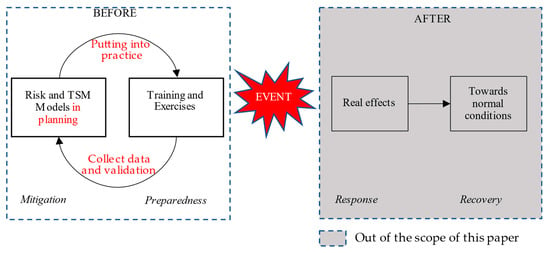
Figure 2.
Interactions between planning and exercises.
2.1. Disaster Risk Models
Planning a system for emergency conditions implies the evaluation of risk (R) and their components [22]:
where:
R = O·V·E
- O is the occurrence that a disastrous event takes place;
- V is the vulnerability of system’s components in relation to the event’s effects;
- E is the exposure of each component with respect to the effects produced by the event.
Equation (1) can be represented with the graphics reported in Figure 2 where the magnitude M is given by the product of vulnerability and exposure.
Through the evaluation of the risk components, different types of events can be defined. Each risk component can be characterized by a reference period, which, depending on the calamitous event, can extend from a few years to a few days or even a few moments. The definition of times and the related intervals is necessary to make it possible to identify the various phases of the event. Emergency events have been classified in the literature with respect to times and intervals.
In the following section, the paper focuses on interventions related to the evacuation of a system aimed at reducing risk in their exposure component. This is possible to quantify as follows:
- Ex post measures of exposure measuring transport system performance in evacuation conditions. In this case, it is possible to implement an evacuation procedure by means of an exercise procedure that follows a common standard (see Section 2.2). It is also possible to monitor the procedure for collecting data and information by means of tools derived from information and communication technologies (ICT).
- Ex ante measures of exposure: by adopting a TSM approach to estimating the performance of a transport system under evacuation conditions, this implies the introduction of specific assumptions about transport supply (for instance the asset of road infrastructure) [23], transport demand, user behavior [24], and interactions between transport supply and demand [21] (see Section 2.2).
It is possible to assume that each intervention implemented (through exercises and training) before the occurrence of a disaster event produces an exposure reduction (ΔE), contributing to risk reduction:
ΔR = O·V·ΔE
With the same levels of occurrence and vulnerability, it is possible to reduce exposure (ΔE) through an intervention that improves evacuation performance. Figure 3 reports an example of risk reduction from risk level R2 to the lower level R3, produced by the reduction of exposure from E2 to E3 and magnitude from M2 to M3:
R2 − R3 = ΔR = O·V·(E2 − E3) = O·V·ΔE
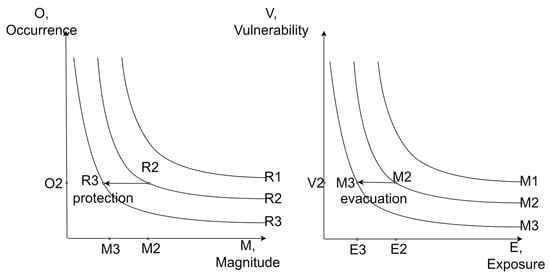
Figure 3.
Risk reduction by reducing exposure.
2.2. Mitigation Phase: Planning Evacuation Modeling
One of the main actions in the risk mitigation phase concerns the implementation of a planning process aimed at defining a scenario to be adopted in an emergency situation. The planning process is influenced by the initial level of risk in terms of objectives, constraints, and strategies. Based on the objectives and targets that are intended to be achieved, an evacuation plan, in a given scenario of risk, can be defined as translating strategies, in terms of the specific interventions to be adopted in the event of an emergency, to facilitate the mobility of people towards safe places.
The effects of each hypothesized scenario can be estimated using the TSMs specified for extraordinary conditions. In particular, it is possible to simulate the transport system in evacuation conditions to evaluate ex ante whether the planned scenario reduces risk compared to the ordinary situation, R0, in order to pursue the planned objectives while respecting the constraints. Following interactions between technicians and decisionmakers, the product (a plan) is obtained which, if implemented, determines, under optimal conditions, the maximum theoretical reduction the planned risk level for future situation, defined by Rmin. The schematic framework of the evacuation planning process, aimed at producing a single plan, is shown in Figure 4.
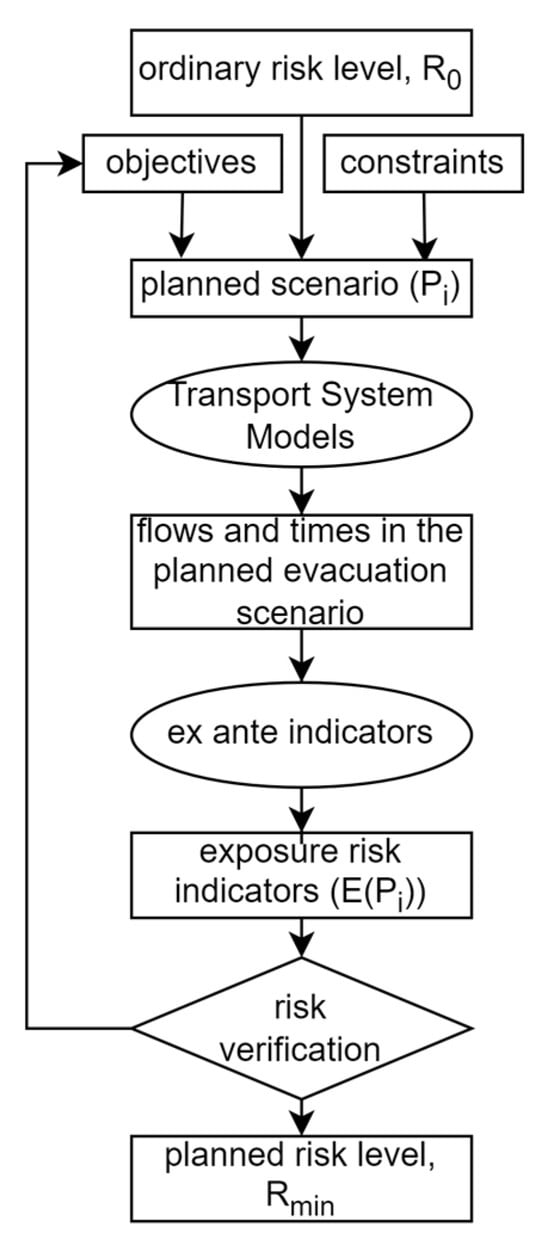
Figure 4.
Framework of the evacuation planning process.
The application of TSMs in the planning phase makes it possible to optimize evacuation and, therefore, reduce exposure. Specifically, the TSM enables the calculation of the evacuation times equivalent to the demand, the quantity of demand evacuated for each available time interval, and all the other variables that represent the conditions of the system. From these results, it is possible to calculate the values of variables that define the exposure conditions.
In these hypotheses, if Pi is the generic plan, in a “what if” approach, we can indicate with E(Pi) the exposure relative to the plan Pi, we can indicate with P0 the plan for ordinary conditions, and, with E0, the exposure in ordinary conditions. Then, we obtain the generic plan Pi, proposed for extraordinary conditions:
E(Pi) < E0
With a reduction in exposure given by:
ΔEi = E0 − E(Pi)
It is possible to assume that the best plan for a specific scenario is the one for which ΔEi is at its maximum and E(Pi) is at its minimum. Briefly, we indicated these values with ΔEpmax and E(Pmin).
The values of the output variables relative to the generic plan Pi in terms of flows and times can be obtained using the TSM. In Appendix A, the main equations that define the TSM are reported.
In general, it is possible to use more indicators to calculate the quality and quantity of exposure E(Pi). So as not to distract attention from the main problem, only one general indicator will be considered; for instance, given by to the time to evacuate the whole population of an area, indicated by ti, or the generic planned condition Pi. It is possible to calculate the exposure E(ti) instead of E(Pi) in the scenario Pi and the exposure E(t0) under ordinary conditions. With these values it is possible to calculate the reduction in ΔE(ti) with respect to the ordinary conditions, indicated by t0. Then, it is possible to calculate the maximum quantity of exposure reduction, in relation to the different condition of ti, calculating the maximum reduction:
ΔEmax = max ti (E(t0) − E(ti)) = E(t0) − E(tmin)
By hypothesizing a direct relationship between ti and E(ti), indicating with tmin the minimum level of exposure calculated by applying the TSM to extraordinary conditions, the minimum exposure can be indicated by E(tmin). Recalling Figure 4, it is possible to insert into Equation (2) the numerical results given by Equation (5).
Figure 5 depicts an example of exposure reduction ΔE measured in terms of a percentage of the evacuated population, for each scenario Pi and time ti, instead of the totality as in Equation (5). Note that the percentage can vary in relation to the presence of a plan. The figure shows two different scenarios: the red function represents the cumulative percentages of people who evacuate without an evacuation plan; the green function represents the cumulative percentages of people who evacuate following an evacuation plan. The green area comprising the two functions represents the exposure reduction obtained by an evacuation plan. It emerges that, by fixing ti, the percentage of the population increases.
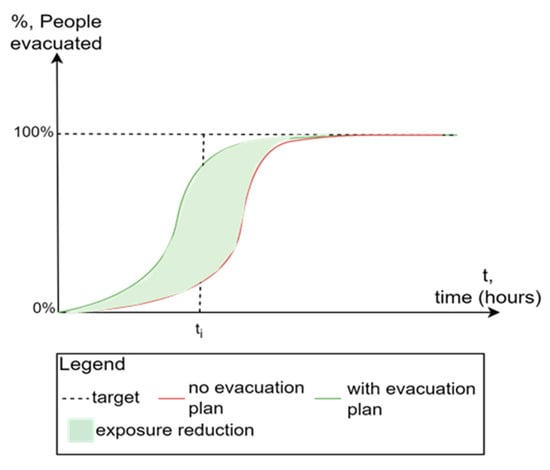
Figure 5.
Example of exposure reduction.
By considering the theoretical configuration of a TSM that gives tmin, by which the lower level of risk is defined (Rmin), the problem can be rewritten in a different form: how people can effectively reduce their risk of reaching the theoretical minimum as summarized in Equation (5) and estimated by a TSM?
2.3. Preparedness Phase: Training and Exercises
The experimental theme that the preparedness phase assigns to the public entity and, therefore, to the disaster managers, is the one summarized in the final question in Section 2.2.
In the following, it is assumed that a generic training session or exercise produces a quantity of exposure reduction.
Under ordinary conditions, the exposure’s value, indicated by E0, refers to a context without any evacuation plan. The best reduced exposure evaluated by means of an evacuation plan is indicated by E(Pmin) or, in the case of only one indicator ti, by E(tmin).
If Tj is the generic action of training or exercises, we can indicate with E(Tj) the exposure after the implementation of the activity Tj. Then, considering that each action Tj increases the knowledge and capabilities of the manager involved in the risk situation, and recalling the quantities E0 and E(Pmin) introduced previously, it is possible to write the following quantitative order:
Emin = E(Pmin) ≤ E(Tj) ≤ E0 = E(P0)
Therefore, by hypothesizing independent results for each exercise, it is possible to write:
ΔEj = E0 − E(Tj)
By assuming that an increasing number of exercises and training actions produces an increased level of exposure reduction until the limit value of Emin, it becomes possible to write:
where
ΔETmax = Σj=1,n ΔE(Tj)
ΔETmax is the total reduction produced by the set of n actions of training and exercises conducted, coinciding (at limit) with the maximum reduction calculated by the plan ΔEPmax.
Equation (8) is extended to all possible training actions, as discussed in Section 3.
Let y be a sequence of days, constituted by only the days when the actions of training or exercises are performed. Then, in the generic day yi the generic action Tj is performed.
Fixing occurrence and vulnerability, in a general view, it is possible to indicate with R0 the risk level at the time y0 (current state) and with Rn the risk level at the time yn. Each exercise Tj (e.g., seminar, workshop) reduces the risk of the quantity ΔRj.
We assume that during the temporal time interval (y1, yn] a set of n exercises (or training) are designed and developed and Tj is the generic exercise. After this cycle of exercises the risk reduction is:
ΔRtot = R0 − Rn = Σj=1,n ΔRj
Figure 6 represents a possible trend of a risk function inside the temporal time interval (y0, yn). The risk level decreases from the initial value R1 to the value Rn.
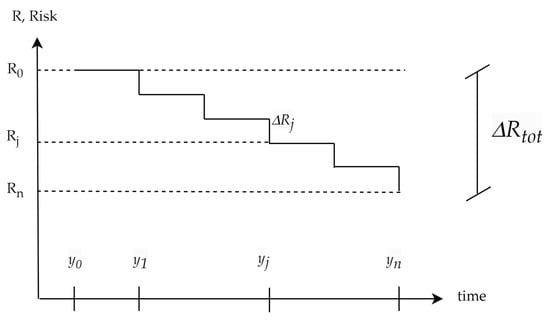
Figure 6.
Trend of risk reduction with successive exercises.
3. Training and Exercise Characteristics
Section 2 recalled the method to individuate the minimum level of exposure by planning, and it proposes a method to formalize the risk reduction through training and exercises. The reduction brought about by planning can be calculated from the one that can be calculated (in the presence of an event) by comparing a transport network organized for the ordinary state to one optimized for the extraordinary state. This reduction can be defined as “planned reduction” and belongs to the mitigation phase.
Note that the best plan, if not known by users and managers, cannot produce any risk reduction. On this basis, an aggregate method was proposed for the evaluation of subsequent risk reductions from the current state to the planned state through training and exercise activities.
This section seeks to specify the theoretical formulations proposed in the previous sections. In this way, the section first recalls an integrated set of actions (training and exercises) that can be implemented; subsequently, assuming for simplicity the independence of the results of each action, a disaggregated model is formulated to calculate the reduction resulting from each implemented action.
Following the USA approach [25], these actions can be grouped into two main classes (Figure 7):
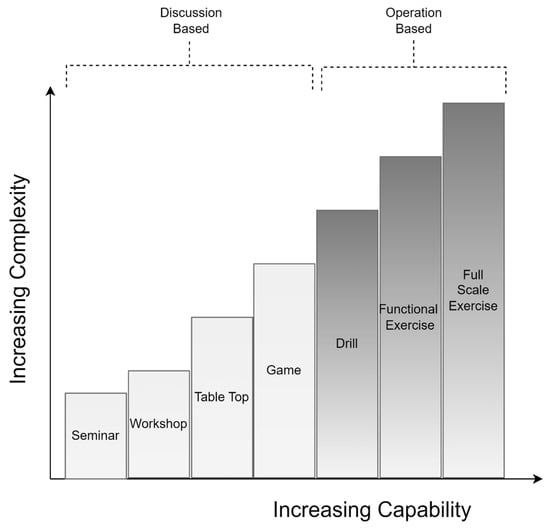
Figure 7.
Classes of exercises.
- Discussion-based actions centered on meetings between actors involved in a potential emergency situation. These are low-cost activities aimed at reviewing or developing emergency plans and procedures, including seminars, workshops, tabletop exercises, and games.
- Operation-based actions centered on real-world experimentation including actors and people involved in a potential emergency situation. These are more complex activities aimed at testing emergency plans and procedures, including drills, functional exercises (FE), and full-scale exercises (FSE).
Exercises are part of a cycle organized according to the PDCA (plan, do, check, act) framework [26].
Sometimes, two or more exercises belonging to different class are realized in sequence, constituting a “building block”; for instance, a sequence constituted by a seminar, which leads to a table-top exercise (TTE), which leads to a full-scale exercise (FSE).
The main characteristics that can be assigned to each activity are:
- Capability, which relates to the combination of available human and material resources for achieving outcomes (e.g., reducing evacuation times) under specific conditions;
- Complexity, in terms of the number and typology of actors involved, providing enhanced realism to the exercise.
The quantity of risk reduction can be measured by adopting:
- A modeling approach by means of a set of TSM equations adapted for simulating a transport system under evacuation conditions including demand, supply, and demand–supply interaction models in order to estimate performance (e.g., times and flows);
- A monitoring approach by means of a set of advanced ICT tools for measuring the performance of the transport system under evacuation conditions; simulated by the implementation of exercises.
In a theoretical context, the quantity of risk reduction that can be achieved with each exercise results from the difference between two risk levels:
- The before risk level, corresponding to a situation characterized by the limited experience of a simulated evacuation scenario;
- The after risk level, corresponding to an increased preparedness level obtained through exercises that simulated the planned evacuation scenario.
The two quantities are used to estimate the contribution of a specific training action to risk reduction.
Experimentally, a simple exposure reduction indicator can be considered, t, the total time required to evacuate the whole population, as introduced in the previous chapter. It is possible to calculate t in the exercise Tj. It is possible to assume that the planner knows the value of exposure without the plan, E0, and with the plan Emin.
The risk reduction produced by the action of each exercise and training session can be measured by applying specific monitoring tools and can also be supported by emerging ICTs. In relation to a specific emergency event, the following assumptions can be introduced:
- The event, its occurrence, and vulnerability, are defined as the base scenario, indicated by S;
- Occurrence and vulnerability values are constant; then risk reduction depends only on the quantity of exposure;
- Effects produced by different planned actions are independent.
Note that there are different risk scenarios in the same area: earthquake, flood, transport of dangerous goods, etc.
With these assumptions, the risk in the generic scenario S depends on the exposure. A set of n actions can be designed and implemented to reduce exposure and then risk, moving from E0, under ordinary conditions, to Emin under a planned for S.
A set of actions, training, and exercises can be defined for each scenario S and represented with the following vector:
where aSk is the generic k training action for the scenario S.
aS = (aS1, aS2, …, aSk,…, aSn)
Each action aSk contributes to reduce exposure in the scenario S. It is possible to specify a vector eS before and after the implementation of aS that gives the level of indicator (S) for the component k:
where g (·) is the function for estimating exposure in relation to exercises in the scenario S.
eS = g (aS)
If the hypothesis on the independency of results, between different actions, is used, then the before exposure level is:
where αSi≠k, are the values produced by actions different to aSk, the constant before and after aSk, and f(·) is the function that, from the vector es, gives the aggregated value of ES.
ESbefore = f(eSbefore) = f(g (αS1, αS2, …, aSk = 0, …, αSn))
The after exposure level can be obtained with the same assumptions as:
ESafter = f(eSafter) = f(g (αS1, αS2, …, aSk ≠ 0, …, αSn))
The exposure reduction obtained with the implementation of ask is:
ΔESk = ESbefore,k − ESafter,k
This coincides with the previous definition in Equation (6).
Before and after the realization of aSk, it is possible to implement monitoring methods that measure transport performance (transport monitoring) and then calibrate the functions f(·) and g (·) (Figure 8).
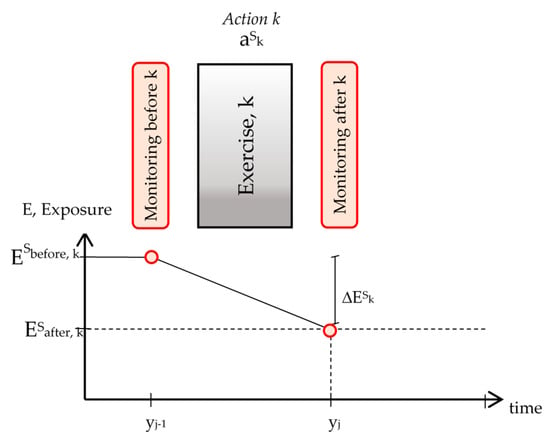
Figure 8.
Exposure reduction related to training action k.
4. Discussion of Evidence from Implemented Exercises
The general aggregate formalization proposed in Section 2 and the disaggregated specification presented in Section 3 can be verified by means of evidence derived from implemented exercises.
In 2002, the US Department of Homeland Security (DHS) introduced the Homeland Security Exercise and Evaluation Program (HSEEP) approach with the aim of providing a framework for how to integrate exercises and emergency planning. The document was published in different releases, becoming a relevant part of the “National Preparedness System” (NPS) aimed at achieving the “National Preparedness Goals” (NPGs). The final goal is to increase the level of preparation of the community for all types of disasters and emergencies [27]. The exercise cycle of HSEEP is a relevant part of the integrated preparedness cycle, consisting of a set of guidelines for orienting the design, conduct, evaluation, and improvement of planning processes, where education, training and exercises represent the main core. It is constituted by a cycle of training programs and exercises implemented with increasing levels of complexity. Each exercise adds new competencies and increases the level of preparedness of the participants. Evaluation constitutes a major component of the preparedness cycle, in terms of orienting decisionmakers to increase emergency planning effectiveness; and the exercise cycle, in terms of assessing the capabilities needed to perform a function or to achieve an objective [25].
In 2005, New Orleans suffered the effects of Hurricane Katrina. The main weakness of the evacuation procedures implemented was connected to the inability to evacuate the most vulnerable people with reduced mobility autonomy; for example, due to lacking their own vehicle (e.g., “carless users”). In this context, it is necessary to note that the problem of accessibility to standard public services had been largely underestimated [28], and the problem of transport services for people with special needs to be activated in emergency conditions was completely understudied. The event subsequently served as a stimulus for the community to increase its level of disaster preparedness. Among the most significant experiences, the University of New Orleans created the Center for Hazards Assessment, Response & Technology (UNO-CHART), an applied research center for “social science hazards” that collaborates with Louisiana communities including the City of New Orleans. The center supports communities with research on sustainability and resilience related to natural, technological, and environmental risks. The scientific community, students, and public authorities work together on understanding and reducing disaster risks. In this context, in 2017, the City of New Orleans designed and implemented two successive evacuation exercises, in advance of the hurricane season. The exercises were aimed at testing the City Assisted Evacuation (CAE) process, designed with the aim of facilitating the evacuation of people who have a low level of autonomy in movement. The two exercises were part of a “CAE Exercise Series”: the first is a tabletop exercise, in which representatives of different agencies that support emergency management are present. The purpose of the TTE is to discuss a hypothetical hurricane evacuation scenario, pursuing the following objectives:
- Evaluating decision-making processes and the capacity to perform a mandatory hurricane evacuation by implementing the plan and the City Emergency Operations Plan (CEOP);
- Discussing methods to inform to the community about evacuation procedures;
- Identifying elements for improving the CAE and CEOP;
- Discussing the procedures to conduct the re-entry and reunification of the affected population post-hurricane.
The discussions developed during the first TTE were preparatory in terms of the second exercise, developed according to the Full-Scale Exercise model, to test procedures in a real environment (real-world operations). The New Orleans FSE tests procedures for collecting people at certain points of the territory (Evacuspots) and then moving them to safe places. During the exercise, personnel and equipment are deployed in places in the area intended for emergency logistics. The TTE is therefore aimed at verifying how the plan can be put into practice, identifying any critical issues and subsequent improvement actions. The set of exercises produced benefits for real emergency situations, in terms of reduced delays and inefficiencies. The improvements for the emergency services produced a significantly increase in the rate at which evacuees are processed and transported to safe places, reducing their exposure. The number of residents assisted through CAE increased from the 18,000 during Hurricane Gustav in 2008, to 40,000 in 2017 during Hurricane Harvey [29]. In this context, TSM supports evacuation managers in reducing traffic congestion during evacuation procedures. For instance, Feng and Lin [30] proposed a TSM approach to supporting the formulation of evacuation orders during Hurricane Irma.
The recalled experiences are part of a strategic planning approach coherent with the consolidated PDCA framework.
5. Final Remarks and Future Perspectives
After relevant disaster events, some countries have felt the need to adopt standard procedures for testing emergency plans. Exercises are an opportunity to review and improve plans. They increase the awareness of the organizers and participants of the exercises. The final aim is to contribute to risk reduction because they produce improvements in evacuation procedures by reducing the risk exposure component. Some of these exercises can be carried out with a very limited quantity of resources.
European legislation on civil protection establishes the procedures but does not require the carrying out of exercises. Repetition of the same exercise (e.g., a seminar) helps to increase awareness of procedures and errors and to improve elements thereof. Moreover, increases in the complexity of an exercise enable people to increase their ability to respond during an emergency event. At the same time, it is necessary to adopt a TSM approach to simulate the effectiveness of actions before their implementation. In this case, model simulations and exercise simulations should be integrated. Mutual interchanges must be generated between the two simulation activities in order to increase knowledge of the phenomenon. The real phenomenon occurs with a very low frequency and is therefore difficult to observe directly. However, exercises are a tool to approximate reality, even if some conditions (e.g., panic) are difficult to reproduce.
With this paper and those of this type and about this research topic, the current gap between the best-designed plan and its effectiveness when disastrous events occur is closed. In fact, without training and exercises, it is very hard to achieve the expected outcomes and goals. This research can have further developments in different directions.
The first direction concerns the model’s accuracy in terms of simulating the transport system under evacuation conditions. It is possible to use ICT technologies to acquire information in order to better understand the phenomenon. Greater integration between ICT technologies and TSMs is needed to offer reliable tools to support decisionmakers.
A second direction concerns the ability to carry out and observe the exercises. Existing methods for evaluating exercises can be supported by a TSM. Also, in this case, it is necessary to adapt ICT solutions integrated with the TSM to support the carrying out of the exercises.
The third direction concerns the estimation of risk reduction connected to the adoption of models and exercises. It is possible to experiment the integration of consolidated risk analyses, based for instance on the bow-tie consolidate approach ([31], with a TSM for estimating the risk exposure component. It is necessary to build models to estimate the contribution to risk reduction of each training and exercise activity. These quantifications require more insights.
Author Contributions
Conceptualization, F.R. and C.R.; methodology, C.R.; validation, F.R.; investigation, C.R.; resources, F.R.; writing—original draft preparation, F.R. and C.R.; writing—review and editing, C.R.; supervision, F.R.; funding acquisition, F.R. All authors have read and agreed to the published version of the manuscript.
Funding
This study was carried out within the research project “RISK: Recovery Increasing by Social Knowledge”-2022B4TT2M (CUP C53D23004800006), PIANO NAZIONALE DI RIPRESA E RESILIENZA (PNRR) Missione 4 “Istruzione e Ricerca”—Componente C2, Investimento 1.1 “Fondo per il Programma Nazionale di Ricerca e Progetti di Rilevante Interesse Nazionale (PRIN)”, D.D. n. 104 del 2 febbraio 2022, ERC SH7 “Human Mobility, Environment, and Space”. This paper reflects only the authors’ views and opinions, neither the European Union nor the European Commission nor the Italian Ministry for Universities and Research can be considered responsible for them.
Institutional Review Board Statement
Not applicable.
Informed Consent Statement
Not applicable.
Data Availability Statement
All the data used are reported in the paper.
Conflicts of Interest
The authors declare no conflicts of interest.
Appendix A. Transport System Models
The Transport System Model (TSM) approach is generally adopted to simulate transport system performance under ordinary conditions. The same approach can be adopted to obtain an estimation of the same performance under both ordinary and extraordinary conditions. The main equations that define the TSM are reported in Cantarella et al. [19].
The system of six equations allows analysts to estimate a transport system’s performances under evacuation conditions. It is possible to follow a “what if” approach to simulating the effects of planned actions that modify the assets of transport services and infrastructure for facing emergency; or a “what to” approach to designing the optimal configuration of transport system that generates the minimum level of exposure ([20,21,32]). A review on evacuation transportation modeling is proposed by [14].
Yamori and Sugiyama [33] designed a smartphone app to support an evacuation procedure that is activated in response to a tsunami event. The app is a tool that measures interactions between the user’s behavior and the natural systems in terms of the tsunami’s temporal evolution. The proposed model can help to increase the preparedness of participants. However, this app is limited to revealing the evacuation path; no indication of planning is given.
The process for obtaining results from a TSM requires a set of data and information useful for specifying the simulation functions, calibrating the parameters, and validating results. For these reasons, it is possible to use emerging ICT tools useful for updating travel utilities [34] and then dynamic travel choices under emergency conditions. ICTs and TSMs can be integrated inside a spatial decision support system (DSS) that emergency managers use to obtain preventive responses regarding the effects of their choices [35].
The TSM incorporates analytical expressions for simulating transport system components and their mutual interactions. These are represented in the following way:
- The demand that includes:
The route utility function
where:
vi = −ψi wi ∀i
- ψi is utility-scale parameters in the route choice model, for o-d pair i;
- wi is the block of the vector of total route costs for o-d pair i;
The route choice function
where:
pi = pi (vi; θi) ∀i
- θI is the choice function parameter vector, whose meaning depends on choice model specification;
- pi is the block of the choice function parameter vector, whose meaning depends on the choice model specification;
The route–choice flow consistency relationship
where:
hi = di pi ∀i
- di is the demand flow for o-d pair i;
- The supply model that includes:
- The arc costs function depending on arc flows (f) and arc capacity (κ),c = c (f, κ)
- The arc–route flow consistency relationshipf = B ∙ h + fz
where:
- B is the arc–route generalized incidence matrix (ARGIM);
- H is the vector of route flows;
- fz is the vector of other arc flows not due to route flows.
The route–arc cost consistency relationship
where:
wi = BiT ∙ c + wZi ∀i
- Bi is the block of the ARGIM for each o-d pair i;
- wZi is the block of the vector of other route costs for o-d pair i;
- fz is the vector of other arc flows not due to route flows.
References
- CRED, Centre for Research on the Epidemiology of Disasters. Emergency Events Database (EM-DAT). Available online: https://www.emdat.be/ (accessed on 23 December 2023).
- Jones, R.L.; Guha-Sapir, D.; Tubeuf, S. Human and Economic Impacts of Natural Disasters: Can We Trust the Global Data? Sci. Data 2022, 9, 572. [Google Scholar] [CrossRef] [PubMed]
- UNDRR Enhancing Disaster Preparedness for Effective Response. Words into Actions. Available online: https://www.undrr.org/media/43008/download?startDownload=true (accessed on 6 December 2023).
- Kates, R.W.; Colten, C.E.; Laska, S.; Leatherman, S.P. Reconstruction of New Orleans after Hurricane Katrina: A Research Perspective. Proc. Natl. Acad. Sci. USA 2006, 103, 14653–14660. [Google Scholar] [CrossRef] [PubMed]
- US Commission the 9/11 Commission Report. Available online: https://www.9-11commission.gov/report/911Report.pdf (accessed on 8 August 2023).
- Monet, J.-P.; Schaller, P.; Pirone, S.; Ribau, M.C.; Poyau, S.; Dumas, M.; Lampris, C. Civil Protection in Europe: Towards a Unified Command System? Lessons Learned, Studies and Ideas about Change Management. In Proceedings of the 17th Information Systems for Crisis Response and Management Conference, Blacksburg, VA, USA, 24–27 May 2020; pp. 315–325. [Google Scholar]
- United Nation. UN Sustainable Development Goals (SDG). Available online: https://sdgs.un.org/goals (accessed on 7 May 2023).
- United Nation. UN SDG Indicators. Global Indicator Framework for the Sustainable Development Goals and Targets of the 2030 Agenda for Sustainable Development. Available online: https://unstats.un.org/sdgs/indicators/indicators-list/ (accessed on 7 May 2023).
- Silva, E.C. Consequence Analysis, Layer of Protection Analysis, and Bowtie as Strategies to Prevent Accidents. Process Saf. Prog. 2023, prs.12542. [Google Scholar] [CrossRef]
- Book, G. Lessons Learned from Real World Application of the Bow-Tie Method. In Proceedings of the SPE Middle East Health, Safety, Security, and Environment Conference and Exhibition, Abu Dhabi, United Arab Emirates, 2 April 2012; SPE: Abu Dhabi, United Arab Emirates, 2012; p. SPE-154549-MS. [Google Scholar]
- Russo, F.; Rindone, C.; Trecozzi, M.R. The Role of Training in Evacuation. In Proceedings of the 8th International Conference on Simulation in Risk Analysis and Hazard Mitigation, Island of Brac, Croatia, 19–21 September 2012; pp. 491–502. [Google Scholar]
- Roud, E.; Gausdal, A.H.; Asgary, A.; Carlström, E. Outcome of Collaborative Emergency Exercises: Differences between Full-scale and Tabletop Exercises. J. Contingencies Crisis Manag. 2021, 29, 170–184. [Google Scholar] [CrossRef]
- Skryabina, E.A.; Betts, N.; Reedy, G.; Riley, P.; Amlôt, R. The Role of Emergency Preparedness Exercises in the Response to a Mass Casualty Terrorist Incident: A Mixed Methods Study. Int. J. Disaster Risk Reduct. 2020, 46, 101503. [Google Scholar] [CrossRef] [PubMed]
- Murray-Tuite, P.; Wolshon, B. Evacuation Transportation Modeling: An Overview of Research, Development, and Practice. Transp. Res. Part C Emerg. Technol. 2013, 27, 25–45. [Google Scholar] [CrossRef]
- Wong, S.D.; Broader, J.C.; Walker, J.L.; Shaheen, S.A. Understanding California Wildfire Evacuee Behavior and Joint Choice Making. Transportation 2023, 50, 1165–1211. [Google Scholar] [CrossRef]
- Radow, L. Tabletop Exercise Guidelines for Planned Events and Unplanned Incidents/Emergencies; US Department of Transport: San Francisco, CA, USA, 2007. [Google Scholar]
- McCreight, R. An Introduction to Emergency Exercise Design and Evaluation; Government Institutes, Bernan Press: Lanham, MD, USA, 2023; ISBN 978-1-60590-759-8. (In English) [Google Scholar]
- Cascetta, E. Transportation Systems Engineering Theory and Methods; Springer: New York, NY, USA, 2013; ISBN 978-1-4757-6873-2. [Google Scholar]
- Cantarella, G.E. Dynamics and Stochasticity in Transportation Systems: Tools for Transportation Network Modelling; Elsevier: Amsterdam, The Netherlands, 2020; ISBN 978-0-12-814353-7. [Google Scholar]
- Marcianò, F.A.; Musolino, G.; Vitetta, A. Signal Setting Design on a Road Network: Application of a System of Models in Evacuation Conditions. WIT Trans. Inf. Commun. Technol. 2010, 43, 443–454. [Google Scholar]
- Vitetta, A. Network Design Problem for Risk Reduction in Transport System: A Models Specification. Int. J. Transp. Dev. Integr. 2022, 6, 283–297. [Google Scholar] [CrossRef]
- Russo, F.; Vitetta, A. Risk Evaluation in a Transportation System. Int. J. Sustain. Dev. Plan. 2006, 1, 170–191. [Google Scholar] [CrossRef]
- Musolino, G. Risk Reduction in Transport System in Emergency Conditions: A Framework for Supply Analysis. WIT Trans. Built Environ. 2022, 206, 275–284. [Google Scholar]
- Russo, F.; Chilà, G. Safety of Users in Road Evacuation: Modelling and DSS for Demand. WIT Trans. Ecol. Environ. 2009, 120, 465–474. [Google Scholar]
- US Federal Emergency Management Agency. FEMA Homeland Security Exercise and Evaluation Program. Available online: https://www.fema.gov/emergency-managers/national-preparedness/exercises/hseep (accessed on 3 January 2024).
- Soujaa, I.; Nukpezah, J.A.; Dimitrijevska-Markoski, T. A Balanced Scorecard Approach to the Homeland Security Evaluation and Exercise Program. Risk Hazards Crisis Public Policy 2023, rhc3.12285. [Google Scholar] [CrossRef]
- US Department of Homeland Security (DHS) Homeland Security Exercise and Evaluation Program. Volume I: HSEEP Overview and Exercise Program Management. Available online: https://www.ojp.gov/pdffiles1/Archive/205244NCJRS.pdf (accessed on 3 January 2024).
- Campisi, T.; Russo, A.; Tesoriere, G.; Al-Rashid, M.A.A. A Two-Steps Analysis of the Accessibility of the Local Public Transport Service by University Students Residing in Enna. In Computational Science and Its Applications—ICCSA 2023 Workshops; Lecture Notes in Computer Science; Gervasi, O., Murgante, B., Rocha, A.M.A.C., Garau, C., Scorza, F., Karaca, Y., Torre, C.M., Eds.; Springer Nature: Cham, Switzerland, 2023; Volume 14106, pp. 147–159. ISBN 978-3-031-37110-3. [Google Scholar]
- United States. Federal Transit Administration. In Office of Research, Demonstration, And Innovation Evacuation and Return: Increasing Safety and Reducing Risk; 2019. Available online: https://rosap.ntl.bts.gov/view/dot/42665 (accessed on 2 January 2024).
- Feng, K.; Lin, N. Modeling and Analyzing the Traffic Flow during Evacuation in Hurricane Irma (2017). Transp. Res. Part Transp. Environ. 2022, 110, 103412. [Google Scholar] [CrossRef]
- De Ruijter, A.; Guldenmund, F. The Bowtie Method: A Review. Saf. Sci. 2016, 88, 211–218. [Google Scholar] [CrossRef]
- Marcianò, F.A.; Musolino, G.; Vitetta, A. Within-Day Traffic Assignment and Signal Setting in Road Evacuation: A Procedure with Explicit Path Enumeration. WIT Trans. Built Environ. 2011, 117, 403–414. [Google Scholar]
- Yamori, K.; Sugiyama, T. Development and Social Implementation of Smartphone App Nige-Tore for Improving Tsunami Evacuation Drills: Synergistic Effects Between Commitment and Contingency. Int. J. Disaster Risk Sci. 2020, 11, 751–761. [Google Scholar] [CrossRef]
- Russo, F.; Rindone, C. Safety of users in road evacuation: The logical framework approach in evacuation planning. WIT Trans. Built Environ. 2008, 101, 751–760. [Google Scholar] [CrossRef]
- Di Gangi, M.; Belcore, O.M.; Polimeni, A. An Overview on Decision Support Systems for Risk Management in Emergency Conditions: Present, Past and Future Trends. Int. J. Transp. Dev. Integr. 2023, 7, 45–53. [Google Scholar] [CrossRef]
Disclaimer/Publisher’s Note: The statements, opinions and data contained in all publications are solely those of the individual author(s) and contributor(s) and not of MDPI and/or the editor(s). MDPI and/or the editor(s) disclaim responsibility for any injury to people or property resulting from any ideas, methods, instructions or products referred to in the content. |
© 2024 by the authors. Licensee MDPI, Basel, Switzerland. This article is an open access article distributed under the terms and conditions of the Creative Commons Attribution (CC BY) license (https://creativecommons.org/licenses/by/4.0/).